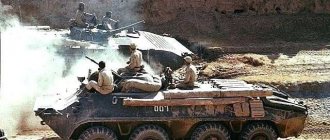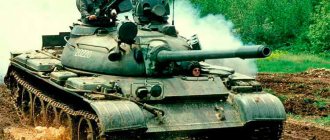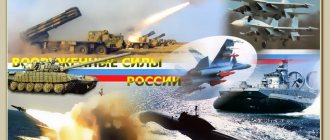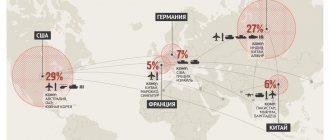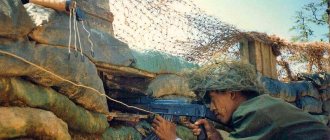BTS-4
BTS-4 is a Soviet armored tractor. Developed on the basis of the T-44M medium tank in the 5th Design and Technology Bureau. Designed to evacuate emergency tanks from the battlefield from the area of enemy fire.
BTS-4 among the equipment left behind after the liquidation of the consequences of the accident at the Chernobyl nuclear power plant
Armored hull and turret
In the bow of the hull there is a control compartment, in which there is a crew of two people. In the middle part there is a loading platform and a traction winch. The cable length is 200 meters and the pulling force is 30 tons.
In the rear part of the hull there is a folding opener. A collapsible boom crane is installed in front of the platform on the left side.
Armament
The delivery package included a Kalashnikov light machine gun (RPK), the ammunition load of which was 1000 rounds. Also, two Kalashnikov AKs were used as the crew’s personal weapons.
Modifications
BTS-4A is a modification of the BTS-4 on the chassis of the T-54 medium tank.
BTS-4V - modification of BTS-4 on the chassis of the IT-1 missile tank.
BTS-4G is a modification of the BTS-4 on the chassis of the T-55 medium tank.
BTS-4AM (BTS-4M) is a modification of the BTS-4 on the chassis of the T-55A medium tank.
BTS-4D (BTS-4AD) - modernization of BTS-4 based on the results of the database in Afghanistan.
Notes
Armored tractor BTS-4 (Russian). Retrieved February 18, 2012.
4 (Russian). Retrieved February 18, 2012. Archived from the original on June 21, 2012.
Go to:1 2A.V. Karpenko, Review of domestic armored vehicles (1905-1995), p. 461
Literature
Tractor units BTS-4 and BTS-4A. Technical description and operating instructions / Ed. Golikova V.V. - M.: Military Publishing House of the USSR Ministry of Defense, 1976. - 414 p.
| Chernobyl. BTS-4 participated in the liquidation of the accident at the Chernobyl nuclear power plant. | |
| BTS-4 | |
| Classification | Tank tractor |
| Combat weight, t | — 31,4 |
| Crew, people | — 2 |
| Story | |
| Manufacturer | USSR |
| Years of production | from - 1965 |
| Years of use | since - 1967 |
| Basic operators | USSR, Russia, Uganda, Ukraine |
| Dimensions | |
| Case length, mm | — 7170 |
| Case width, mm | — 3270 |
| Height, mm | — 3020 |
| Base, mm | — 3800 |
| Track, mm | — 2640 |
| Ground clearance, mm | — 460 |
| Booking | |
| Body forehead, mm/deg. | — 90 |
| Armament | |
| Machine guns | :1 x 7.62mmRPK |
| Mobility | |
| engine's type | diesel V-54-E |
| Engine power, l. With. | — 520 |
| Highway speed, km/h | — 50 |
| Cruising range on the highway, km | — 450—500 |
| Specific power, l. s./t | — 16,56 |
| Specific ground pressure, kg/cm² | — 0,71 |
| Climbability, degrees. | — 30 |
| Ditch to be overcome, m | — 2,85 |
| Fordability, m | — 1.3 (5 with OPVT) |
Honored repairman: BTS-4 tractor
And although vehicles of this type do not always participate in battles in the first line, and not so often in festive columns at a parade, the normal functioning of troops without them is impossible. Therefore, today we will say a few words about this well-deserved car.
BTS-4 LBTZ in the park
BTS-4 was developed on the basis of the T-44M medium tank in 1965 in Kyiv, at the 5th Design and Technology Bureau. Its purpose is to tow tanks (light and medium), pull out stuck combat vehicles, and assist crews with repairs, including under enemy fire. The BTS-4 is equipped with a boom crane, a coulter for securing the tractor to the ground during operation, a towing device for transporting uncontrolled tanks, and a traction winch.
The traction force of the BTS-4 winch is 30 tons. The working length of the cable is 200m. The crew of this vehicle consists of two people; they are located in the control compartment in the bow of the tractor. The vehicle has a set of equipment for underwater driving (a characteristic pipe). The BTS-4 initially did not have its own installed weapons; to protect the crew from the enemy, its equipment included a Kalashnikov light machine gun and two machine guns.
BTS-4 in Pripyat
There are several versions of the BTS-4 tractor. They differ in chassis, the equipment of all variants is identical. Thus, the BTS-4A was made on the basis of the T-54 tank, the IT-1 missile tank destroyers were “demoted” to the BTS-4V version, the BTS-4G was made on the basis of the T-55 tank, and the BTS-4AM was made from the T-55A.
Currently, the main users of this machine are Belarus, Ukraine, Russia, Uganda, Cuba, and the unrecognized Nagorno-Karabakh Republic. Efforts are being made to modernize and extend the service life of numerous tractors of this type. In Ukraine, BTS-4s are being modernized by the Lviv Armored Plant.
In 2022, at the request of the military of one of the Asian states (most likely Myanmar), the BREM (armored repair and recovery vehicle) “Bison” (also known as BTS-4LBTZ) was developed. The modernization concerned an increase in the power of the tractor's winch; now the Zubr can work with loads weighing up to 75 tons.
After this, the Ukrainian military showed interest in the modernized tractors, and an updated version was created for the Armed Forces of Ukraine. The updated vehicle received a new crane installation, equipment for electric welding, a more powerful winch that allows it to work with equipment weighing up to 100 tons, and bulldozer equipment for clearing roads. The crew increased to 3 people.
BTS-4LBTZ
BTS-4 tractors took part in several conflicts. First there was Afghanistan, where armored tractors often transported sappers and moved ahead of the main column of troops. In addition, BTS-4, modernized and re-armed, supported maneuver groups with fire. As a result of the use of these machines in Afghanistan, the BTS-4AD version appeared.
BTS-4 in Afghanistan
They were also used in Chechnya. BTS-4 also took part in combat operations in eastern Ukraine. In these wars, tractors were often rearmed. They were equipped with large-caliber machine guns and ZU-23-2 automatic anti-aircraft guns, which, however, were used to fight not against aviation, but against ground forces. As it turned out, the burst from the BTS anti-aircraft gun, due to its greater mass, can withstand it better, does not swing, and the fire is more accurate.
BTS-4 in Chechnya
BTS-4 also had to participate in eliminating the consequences of the Chernobyl accident. Some of them were abandoned in Pripyat because they received too much radiation, making their decontamination unprofitable.
Currently, BTS-4 is available to private buyers. They can pull out and evacuate stuck special and construction equipment in almost any terrain.
Tracked tractors and ARVs of various types were produced and operated by many countries around the world, from Great Britain to China. If we compare vehicles of comparable age, the closest analogue of the BTS-4 is the American M88 ARV, which has been in production since 1961. It turns out to be even older and more honored, it has also been modernized several times, and serves in many countries.
The technical characteristics of the latest version of the M88 (HERCULES) are inferior to the modernized versions of the BTS-4 (pulling force is 64 tons, the cable is only 85 m long). But, perhaps, the main difference is that the M88 will not be able to boast of such a varied “career”. After all, the BTS-4, in addition to its main job (pulling out and repairing faulty tanks), had to act as a combat vehicle and fight radiation.
BTS-4 of the Ukrainian army
Sources used: gurkhan.blogspot.com, rem-battalion.ru, ukroboronprom.com.ua, vpk.name.
Found a typo? Select a fragment and press Ctrl+Enter.
Tags: Land vehicles BREM T-16 Soviet Union tractor BTS-4
Previous article How the Ukrainians developed a tank for Myanmar
Next article The end of the legend. Ju-87 dive bomber in the Battle of Stalingrad and the Kursk Bulge
Provided by SendPulse
Likes 0
What do BTS sing about and in what genre?
BTS's music comes in an endless variety of genres. Globally, they fall under the category of K-pop or Korean pop music, but more precisely, since their debut, hip-hop, R&B, dance tracks (EDM) and simply pop compositions have been the basis for their work.
You will even find music featuring a symphony orchestra among their songs, lyrical ballads, rock, electronic music and rap.
The themes of the songs are also varied, from mental health to political issues in society, BTS touches on everything they had to face as they grew up. That's why they say: "You will find music for every taste at Beaties."
Operators
- USSR
- Azerbaijan - a number of BREM-1M and at least 14 BTS-5B, as of 2013
- Armenia - a number of BREM-1, as of 2012
- Belarus
- GDR - 15 BREM-1 units were supplied from the USSR between 1985 and 1987
- Georgia - 6 units of BTS-5B were delivered from Ukraine in 2007
- Iraq - 88 units were supplied from Ukraine from 2006 to 2010 under a $7 million contract from 2005.
- Iran - a number of BREM-1, as of 2012
- Cyprus - 1 BREM-1 unit, as of 2012
- Russia - a number of BREM-1, as of 2012
- Syria - a number of BREM-1, as of 2012
- Ethiopia - 4 BTS-5B delivered from Ukraine in 2011
Unified air defense
Multi-purpose Su-35S from the Eastern Military District will strengthen patrols on the external air border of the Union State. Joint flights of Su-30SM fighters of the two countries along the air border began in November last year. Several times they involved long-range Tu-22M3 bombers and Tu-160 strategic missile carriers of the Russian Aerospace Forces.
“Thor” is appropriate: the south of Russia was covered with anti-aircraft robotic guns
In many characteristics, the air defense system is superior to its Western counterparts
After the deployment of the S-400 from the Khabarovsk Territory, they will be integrated into the unified air defense system of Belarus and Russia.
Belarus is part of the unified air defense system of the CIS, former deputy commander-in-chief of the Air Force for the unified air defense system of the CIS countries, reserve lieutenant general Aitech Bizhev, told Izvestia.
“The S-300 anti-aircraft missile systems that Belarus retained from the Soviet Union are already morally and technically obsolete,” he explained. — S-400s are sent for exercises in order to increase the combat capabilities of the Union State of Russia and Belarus. We reduce forces to one denominator. Do not forget that Belarus is a leading outpost. We stand nose to nose with NATO.
During the exercises, air defense personnel will gain unique skills in transporting over long distances, both by rail and on their own. The troops will have to march, enter a given area at a set time, deploy in unfamiliar terrain, join the general air defense system, organize the receipt of information, and bring the equipment into working condition. The situation will be as close as possible to combat, the experience recently gained in Kazakhstan will be taken into account - the security and defense of facilities, airfields, etc., the expert noted.
Military insufficiency
NATO exercises in Poland, 2022
Photo: TASS/TOMASZ WASZCZUK
Notes
- ↑
Armored tractor BTS-4 (Russian). Retrieved February 18, 2012. Archived from the original on June 21, 2012. - ↑ 123
Tracked armored tractor BTS-4 (Russian). Retrieved February 18, 2012. Archived from the original on June 21, 2012. - ↑ 12
A.V. Karpenko, Review of domestic armored vehicles (1905-1995), p. 461 - ↑
Stockholm Internation Peace Research Institute – Arms Transfers Database - ↑
ARMORED VEHICLES IN AFGHANISTAN (1979—1989) - ↑
Experience paid for in blood: TECHNICAL CLOSURE - “Brother” Magazine. Retrieved January 28, 2013. Archived from the original on February 3, 2013.
Across the country
At the moment, the concept of the Allied Resolve 2022 exercises has been approved, and the development of the scenario for the upcoming maneuvers is being completed, sources in the military department told Izvestia. According to the approved documents, several elements will be tested at once during the exercises. Including the fight against regular armed formations, as well as repelling threats from terrorist and destabilizing elements supported from abroad.
“A situation may arise when the forces and means of the regional grouping will not be enough to guarantee the security of the Union State, and we must be prepared to strengthen it,” noted Russian Deputy Minister of Defense Colonel General Alexander Fomin at a briefing for foreign military attaches on January 18. — Together with the Belarusian side, an understanding was reached that for common defense it will be necessary to involve the full potential of the state’s military organization.
The regional grouping of the Union State includes the armed forces of Belarus and part of the troops of the Western Military District of Russia.
Military insufficiency
Photo: RIA Novosti/Ministry of Defense of the Russian Federation
Balcony to Europe: why unscheduled exercises are needed in Belarus
Moscow and Minsk will practice repelling a large-scale invasion at border training grounds
Unscheduled exercises will take place from February 10 to 20 on the territory of Belarus. According to the Russian Ministry of Defense, two divisions of S-400 anti-aircraft missile systems and a Pantsir-S division will be transferred from the Far East to Belarus for the first time. The equipment will be delivered by rail across the country. This will make it possible to determine how ready the transport infrastructure is for such transportation.
In addition, as Izvestia previously reported, a squadron of 12 modern Su-35S multirole fighters will fly from the Dzyomgi airfield in Komsomolsk-on-Amur to Belarus. The necessary ground equipment to service them will also be relocated along with them.
On Friday, a video of the arrival of a train with the Iskander-M operational-tactical missile system in Belarus appeared on social networks.
According to the scenario of the maneuvers, the allies will practice actions in conditions of destabilization of the situation, against the backdrop of which groups of terrorists will try to seize government facilities, military expert Alexei Leonkov told Izvestia.
“The troops will practice repelling a sudden attack by terrorists who will receive military support from abroad, and then defeat these formations,” he explained. — Units of the Special Operations Forces will destroy mock terrorists, and ground forces, paratroopers, air defense forces and aerospace forces will repel external aggression. At the same time, they use the experience gained by Russian and Belarusian units during the recent CSTO peacekeeping mission in Kazakhstan: the operational transfer and concentration of forces, the security and defense of particularly important facilities. Most likely, these same units will be involved in the upcoming exercises.
Military insufficiency
Su-35S multirole fighters
Photo: TASS/Vladimir Gerdo
